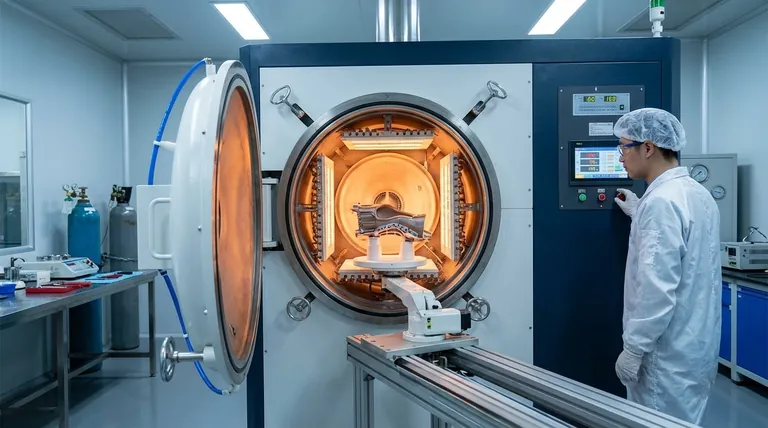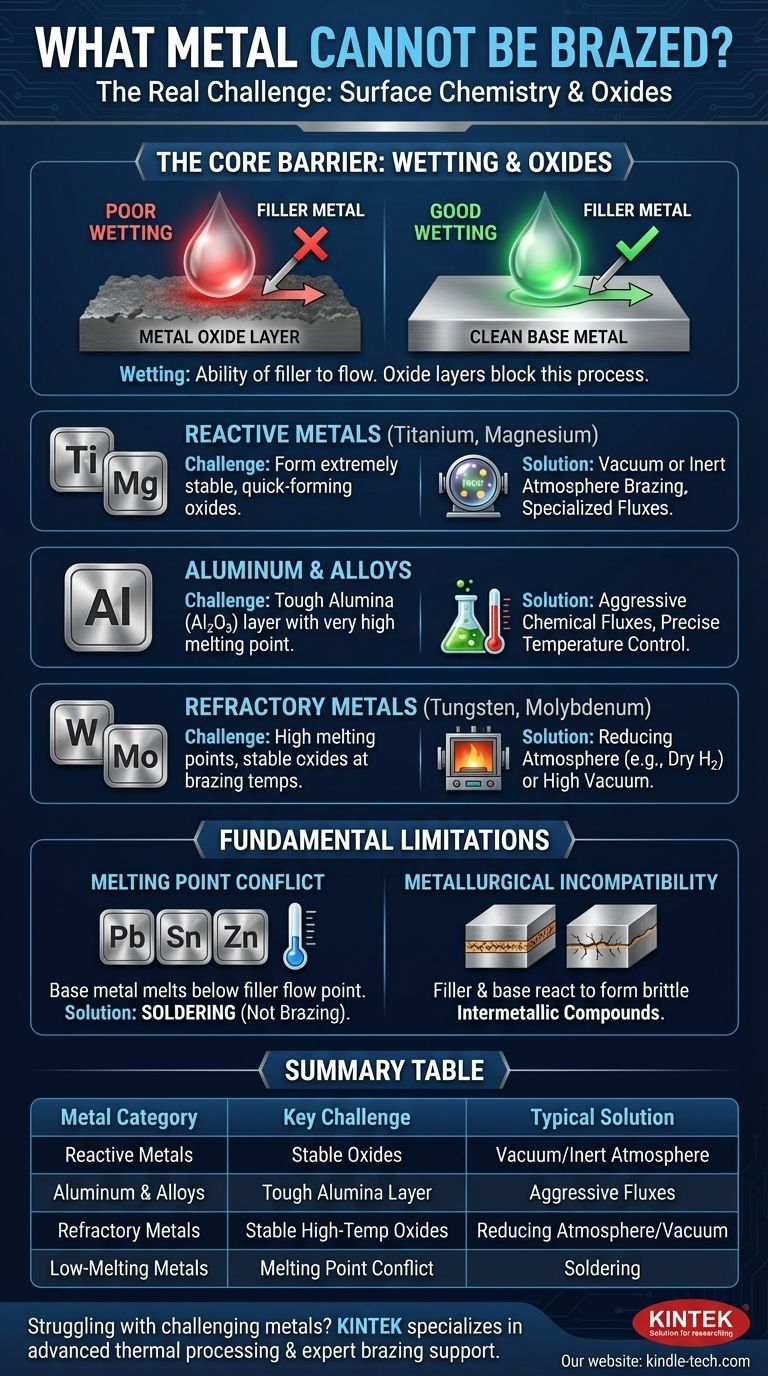In principle, almost no metal is impossible to braze. The real challenge lies not with the metal itself, but with its surface properties, particularly the formation of stubborn oxide layers. Therefore, the question shifts from "what can't be brazed?" to "what is extremely difficult to braze without highly specialized processes?"
The success of a brazing operation is not determined by the bulk metal, but by the ability of the molten filler alloy to "wet" the surface. This wetting action is almost always prevented by a layer of metal oxide, and the difficulty of removing that oxide is the primary barrier to brazing.

The Real Barrier: Understanding Surface Chemistry
Brazing relies on a metallurgical bond between a filler metal and two parent workpieces. For this bond to form, the filler must be able to flow evenly across the surfaces of the parent material.
What is "Wetting"?
Wetting is the ability of a liquid to maintain contact and flow over a solid surface. Think of water beading up on a waxed car—that is poor wetting. The same water flowing into a smooth sheet on a clean, unwaxed hood is an example of good wetting.
In brazing, we need the molten filler metal to wet the base metals perfectly to create a strong, continuous joint through capillary action.
The Role of Tenacious Oxides
Nearly all metals react with oxygen in the air to form a thin, invisible layer of metal oxide. This oxide layer prevents the filler metal from making direct contact with the pure base metal, blocking the wetting process.
Standard brazing uses flux or a controlled atmosphere furnace to dissolve and remove this oxide layer. However, some metals form oxides that are so stable, tough, and quick to reform that standard methods fail.
Metals That Present Significant Brazing Challenges
While technically possible under laboratory or highly specialized industrial conditions, the following metals are notoriously difficult to braze due to their surface chemistry or other properties.
Reactive Metals: Titanium & Magnesium
These metals are prized for being lightweight and strong, but they are highly reactive with oxygen. They instantly form extremely stable oxide layers.
Brazing them requires aggressive, specialized fluxes and often must be done in a vacuum or an inert gas atmosphere (like argon) to prevent the oxide from immediately reforming.
Aluminum and its Alloys
Aluminum's oxide (alumina, Al₂O₃) is exceptionally tough and has a much higher melting point (~2072°C or 3762°F) than the aluminum itself (~660°C or 1220°F).
To braze aluminum, the flux must be chemically engineered to aggressively attack this alumina layer at a temperature just below the metal's melting point. This requires very precise temperature control.
Refractory Metals: Tungsten & Molybdenum
These metals are defined by their incredibly high melting points. While this prevents them from melting during brazing, they form very stable oxides at brazing temperatures.
Like titanium, they typically require brazing in a reducing atmosphere (like dry hydrogen) or a high vacuum to protect the surfaces from any oxygen.
Understanding the True Limitations
Beyond surface oxides, a few fundamental principles make certain combinations impractical or impossible.
The Melting Point Conflict
The most fundamental limitation is temperature. Brazing, by definition, occurs at a temperature below the melting point of the base metals.
If a metal's melting point is lower than the flow point of the filler alloy, it cannot be brazed. This effectively excludes low-temperature metals like lead, tin, and many zinc-based alloys from being joined with standard brazing processes. For these, soldering is the appropriate method.
Metallurgical Incompatibility
Sometimes, even if wetting is achieved, the filler metal and base metal can react to form brittle intermetallic compounds within the joint.
This can create a connection that is mechanically weak and prone to failure under stress or vibration, defeating the purpose of creating a strong joint. This is a concern when brazing dissimilar metals without careful filler selection.
Practical & Economic Impracticality
For materials like titanium or refractory metals, the required equipment (e.g., vacuum furnaces), specialized consumables, and high level of process control can make brazing prohibitively expensive and complex for many applications.
In these cases, other joining methods like Gas Tungsten Arc Welding (GTAW/TIG) are often more practical and reliable.
Making the Right Choice for Your Goal
To select the correct approach, consider the nature of your base metal.
- If your primary focus is joining common steels, stainless steel, copper, or brass: Brazing is an excellent and widely used method; success depends on standard cleaning and proper flux or atmosphere selection.
- If your primary focus is joining aluminum, titanium, or other reactive metals: Brazing is technically possible but demands specialized fluxes, precise temperature control, and often a controlled atmosphere furnace, making it an expert-level task.
- If your base metal melts below 800°F (425°C): Brazing is not the correct process; you need to use soldering with a lower-temperature filler alloy.
Ultimately, successful brazing is less about the specific metal and more about mastering the chemistry required to prepare its surface for bonding.
Summary Table:
| Metal Category | Key Challenge | Typical Solution |
|---|---|---|
| Reactive Metals (Titanium, Magnesium) | Extremely stable, quick-forming oxides | Vacuum or inert atmosphere brazing |
| Aluminum & Alloys | Tough alumina (Al₂O₃) layer | Specialized aggressive fluxes |
| Refractory Metals (Tungsten, Molybdenum) | Stable oxides at high temperatures | Reducing atmosphere or high vacuum |
| Low-Melting Metals (Lead, Tin, Zinc) | Melting point conflict with filler alloy | Soldering (not brazing) |
Struggling to join challenging metals like aluminum or titanium? KINTEK specializes in advanced thermal processing solutions, including controlled atmosphere furnaces and expert brazing support for laboratories and industrial R&D. Our equipment and consumables are designed to handle even the most difficult-to-braze materials, ensuring strong, reliable joints. Let our experts help you achieve perfect results—contact us today for a consultation!
Visual Guide

Related Products
- Vacuum Heat Treat Furnace with Ceramic Fiber Liner
- Vacuum Heat Treat and Pressure Sintering Furnace for High Temperature Applications
- Graphite Vacuum Furnace High Thermal Conductivity Film Graphitization Furnace
- Molybdenum Vacuum Heat Treat Furnace
- Vacuum Heat Treat and Molybdenum Wire Sintering Furnace for Vacuum Sintering
People Also Ask
- Can I vacuum the inside of my furnace? A Guide to Safe DIY Cleaning vs. Professional Service
- What are the advantages of a vacuum furnace? Achieve Superior Purity and Control in Heat Treatment
- What is the standard thickness of plating? Optimize Durability, Corrosion & Cost
- How to vacuum out a furnace? A Step-by-Step Guide to Safe DIY Maintenance
- What materials are used in a vacuum furnace? A Guide to Hot Zone Materials and Processed Metals



















